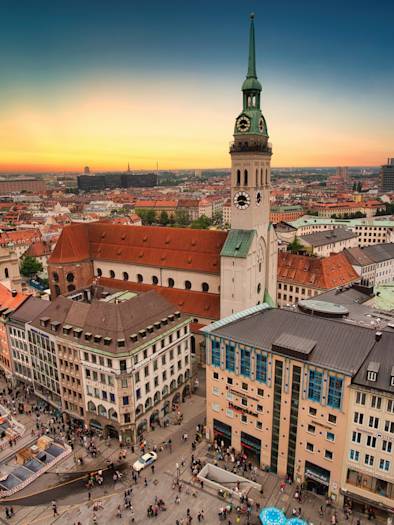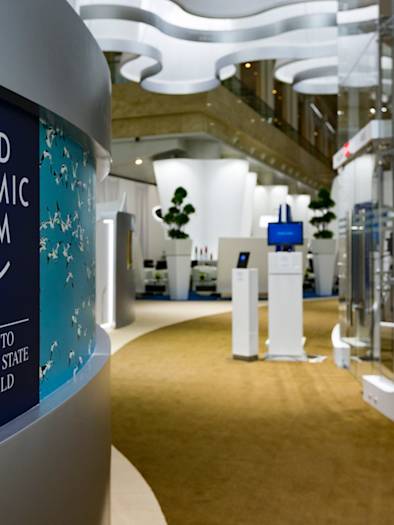
China’s 2021 Two Sessions
Key takeaways from the government work report’s national priorities for 2021, the 14th Five-Year Plan period, and beyond
Last week, China’s most important annual political meetings kicked off as the National People’s Congress (NPC), the national legislature, and the Chinese People’s Political Consultative Conference (CPPCC), the top political advisory body, held their opening sessions on March 5 and 4, respectively.
Commonly known as the lianghui – or the “Two Sessions” – this year’s elite gatherings in Beijing are particularly significant. The Chinese leadership will not only set the national socio-economic and political priorities for 2021 but also approve China’s 14th Five-Year Plan (FYP) (2021-2025), the grand strategic blueprint for the next half decade, as well as longer-term goals for 2035. What’s more, 2021 marks the centenary of the founding of the Chinese Communist Party (CCP), with the 100th anniversary set to be officially commemorated in July.
At the opening of the NPC last Friday, Premier Li Keqiang delivered the annual government work report to thousands of delegates in the Great Hall of the People. In the below update, H+K China has prepared an overview of the main takeaways. Key highlights include the following:
China set a conservative economic growth target of more than 6% for 2021, below most economists’ expectations. The government aims to keep the economy running within an “appropriate range” over the next five years and “set annual targets for economic growth in light of actual conditions.”
The work report confirmed that the new “dual circulation” strategy will be at the heart of China’s economic growth model during the 14th FYP period.
An ambitious national technological blueprint was laid out for the next five years, with the work report emphasizing that “innovation remains at the heart of China’s modernization drive.”
The government further charted out the course towards decarbonizing the economy and achieving China’s ambitious 2030/2060 climate goals.“Action plans” for achieving peak carbon emissions by the end of the decade will be drawn up.
Authorities promised to press ahead with continued liberalization of China’s business environment, announcing plans to further cut the negative list for foreign investment and encourage overseas companies to invest in certain sectors, including advanced manufacturing, new and high technologies, and energy conservation and environmental protection.
The work report vowed that China will continue to “deepen multilateral, bilateral, and regional economic cooperation,” including specific pledges to support the Regional Comprehensive Economic Partnership, the China-E.U. Comprehensive Agreement on Investment, and more.
Beijing is shifting the national strategy of poverty alleviation towards one of rural revitalization. The aim is to achieve “common prosperity” by consolidating the progress made in eradicating poverty and narrowing the wealth-divide between cities and the countryside through the “new, people-centered urbanization strategy.”
Setting a modest economic growth target for 2021
After China was the only major global economy to avoid recession last year, the work report set a GDP growth target of more than 6% for 2021, well below most analysts’ expectations of a stronger recovery unfolding this year. A survey of economists by Bloomberg showed an average annual forecast of 8.4% growth for the Chinese economy. For the next five years, the government said it will aim to keep the economy running within an “appropriate range” and “set annual targets for economic growth in light of actual conditions.”
This year’s conservative target for GDP expansion reflects the continued economic uncertainties around the global pandemic as well as Chinese authorities’ intensifying focus on achieving high-quality rather than high-speed growth. Official concerns about exacerbating domestic financial risks with excessive stimulus likely also contributed to the lower-than-expected GDP goal. Indicating that Beijing will gradually withdraw last year’s pandemic stimulus, the budget deficit for 2021 was set at about 3.2%, below last year’s record high of 3.6%. The special local government bond quota was also lowered by about 100 billion yuan (US$15 billion) compared to that of last year.
For the 14th FYP period, the work report also confirmed that the new “dual circulation” strategy (DCS) will indeed be at the heart of China’s economic growth model in the coming years. While the main thrust of the DCS will be to reorient China more towards its vast domestic market and bolster its economic self-reliance as it faces an increasingly challenging external environment, Beijing has continually emphasized that deepening China’s integration with the global economy remains an absolute priority under the new development paradigm.
Building China into a self-reliant technological powerhouse
As China aims to become a leading innovative country by 2035, the work report laid out an ambitious national technological blueprint for the next five years, emphasizing that “innovation remains at the heart of China’s modernization drive.” The government vowed to focus on achieving “major breakthroughs in core technologies,” including next-generation artificial intelligence, semiconductors, cloud computing, and other key areas, as well as establish more national laboratories and innovation centers.
From 2021-2025, R&D spending will be ramped up by more than 7% every year, with expenditures “expected to account for a higher percentage of GDP” than that during the 13th FYP period. This year, China will increase its spending on basic research by 10.6%. The significant commitments highlighted the government’s determination to continue expanding the role of innovation as a major growth engine for the Chinese economy as well as strengthening domestic innovation capabilities amid growing rivalries with the U.S. and other advanced economies around technology. Reducing China’s technological dependency on external markets and mitigating the vulnerabilities of its supply chains to geopolitical tensions will be a top official priority going forward.
For the first time in a work report, the government also pledged to expand efforts against business monopolies as part of efforts to ensure fair market competition. Coming after the recent launch of an anti-trust crackdown targeting domestic tech giants, the announcement signaled that the tougher approach to governing China’s booming technology sectors can be expected to intensify further. What’s more, it indicated that the trustbusting drive will likely be widened to cover other sectors in the future.
Accelerating the drive towards a low-carbon economy
With China looking to step up efforts to decarbonize its economy, the work report further charted out the course towards realizing the goals of having emissions peak by 2030 and achieving carbon neutrality by 2060. For 2021, the government announced the target of reducing energy intensity by around 3%. Over the next five years, authorities aim to cut energy intensity by 13.5% and carbon intensity by 18%. The work report also said that “action plans” will be drawn up for achieving peak carbon emissions by the end of the decade.
Promising to “make a major push to develop new energy sources,” the government plans to have non-fossil fuels account for 20% of energy use by 2025, compared to 15% at the end of 2019. For example, nuclear power capacity will be expanded by about 40% to reach 70 gigawatts over the next five years. However, while accelerating the push towards renewable energy, Beijing will also continue to promote “the clean and efficient use of coal.”
Emphasizing the importance of “ensuring harmony between humanity and nature,” the work report also said that China will move quicker to create “major ecological shields” aimed at safeguarding natural ecosystems, establish a “national park-based nature reserve system,” and expand forest coverage to nearly a quarter of its total land area. As China prepares to host COP15 later this year, the world’s most important biodiversity conference in a decade, Beijing has prioritized expanding its efforts to protect nature and demonstrate its commitment to shaping and advancing the global biodiversity-conservation agenda.
Moving ahead with gradual liberalization of the business environment
Throughout the pandemic and global recession, Beijing has been at pains to reassure the international business community that its new “dual circulation” strategy (DCS) does not signal a retreat by China from the world economy or a closing of its doors to inward investment. Authorities have continued to stress the Chinese market’s long-term attractiveness and potential and repeatedly underscored commitments to pushing forward with greater liberalization of market access for foreign companies.
While the work report featured less of a focus on the business environment than anticipated, the government did promise to widen market access in certain sectors, announcing plans to further cut its negative list restricting foreign investment. Additionally, authorities said that foreign companies would be particularly encouraged to invest in advanced manufacturing, new and high technologies, and the energy conservation and environmental protection industries, as well as the country’s central and western regions.
These were all welcome signals. However, international businesses should also be aware that the National Development and Reform Commission (NDRC), China’s lead economic planner, said that it will begin carrying out national security reviews of foreign investments later this year. Going forward, foreign investors should expect to see heightened national security oversight of their planned activities in China. This will be especially likely if Chinese companies continue to face escalating regulatory scrutiny abroad.
Elevating China’s leadership role in regional and global governance
Reflecting Beijing’s ongoing push to elevate its leadership role throughout Asia and globally, the work report said that China will continue to “deepen multilateral, bilateral, and regional economic cooperation” over the next five years. This included specific pledges to “uphold the multilateral trading regime,” support the ratification and implementation of the Regional Comprehensive Economic Partnership (RCEP) and the signing of the China-E.U. Comprehensive Agreement on Investment (CAI), and accelerate negotiations on a free-trade agreement with Japan and South Korea.
Additionally, the government reiterated its commitment to “actively consider joining” the Comprehensive and Progressive Agreement for Trans-Pacific Partnership (CPTPP), the successor to the Trans-Pacific Partnership (TPP) that former President Trump withdrew the U.S. from. Against the backdrop of an intensifying great-power rivalry with the U.S., Beijing also said it will “promote the growth of mutually beneficial China-U.S. business relations on the basis of equality and mutual respect,” without providing further details.
During the 14th FYP period, Beijing can be expected to continue leveraging multilateral and bilateral frameworks not only as vehicles to further expand China’s integration with the global economy but also to boost its soft power, in particular with a view to strengthening its positioning as the foremost leader of the next round of globalization. For instance, the RCEP and China-E.U. investment agreement were both widely regarded as major diplomatic wins for Beijing. The government will be looking to further build on those recent successes in the coming years, especially as it faces rising pressure overseas around its trade and economic policies.
Achieving “common prosperity” through rural revitalization and new urbanization
Last month, the Chinese government declared victory in the long fight against poverty, marking the official conclusion of President Xi’s signature campaign to lift nearly 100 million people out of poverty since 2012. Now Beijing is recalibrating the national strategy of poverty alleviation towards one of rural revitalization, with the aim of achieving “common prosperity” by preventing people from falling back into poverty and narrowing the wealth-divide between cities and the countryside.
To help guide those efforts, central authorities recently replaced China’s chief anti-poverty agency with the National Administration for Rural Revitalization in a bureaucratic reshuffle. The new government body will play a leading role in “consolidating and expanding the achievements of the battle against poverty,” which the work report set as a top priority over the next five years. The work report also underscored the importance of continuing to pursue the “new, people-centered urbanization strategy,” pledging to further ease migration barriers between rural and urban areas. Expanding “city clusters” will remain at the vanguard of the urbanization drive moving forward.
The government plans to have China’s urbanization rate reach 65% of the population by 2025 and 75% – that of an advanced economy – by 2035. As more people move from rural to urban areas, this can be expected to fuel greater investment in infrastructure, while the higher incomes typically enjoyed by new city residents will help to boost consumption. And with around 550 million people still living in the countryside, successfully pushing forward the rural revitalization and new urbanization strategies will be critical to sustaining China’s economic growth over the next half decade and beyond.
If you have any questions, please do get in touch with us at GPABeijing@hkstrategies.com. H+K China’s Corporate Advisory and Strategic Communications team can provide more in-depth assessments about this year’s “Two Sessions” and the 14th Five-Year Plan for individual clients upon request.







